Corinaldo is a well-preserved medieval town in the province of Marche, surrounded by intact defensive walls and overlooking the countryside of Ancona province. It’s officially listed among I Borghi più belli d’Italia (the most beautiful villages of Italy) for its authentic historic centre, narrow streets, and traditional brick architecture. The town is famous for its two most recognisable landmarks, the Scalinata della Piaggia, also known as Scala di cento scale (the Staircase of a Hundred Steps), and Pozzo della Polenta (Polenta’s well). Corinaldo offers a clear example of Marche’s rural heritage, where history, local culture, and everyday life are still closely connected.
The town’s origins date back to the early Middle Ages, when people from the Roman settlement of Suasa (not far, today’s Castellone di Suasa) sought refuge on this hill after invasions. During the 14th and 15th centuries, Corinaldo became an important fortified center under the Duchy of Urbino. Today, it remains one of the best-preserved examples of medieval urban architecture in Le Marche, a destination where history, culture, and local traditions meet.
In this page, you can find things to see and do in Corinaldo.
Things To Do In Corinaldo
Climb La Piaggia and Discover the Famous Well
The Scalinata della Piaggia, with its 109 steps, is the heart of Corinaldo. Halfway up stands a picturesque well, the symbol of the town and the setting of the humorous legend of La Polenta di Corinaldo.
A farmer, carrying a sack of cornmeal for making polenta, stopped to rest at the edge of a well on the famous Piaggia staircase. He set the heavy sack down on the edge of the well, and in an instant, it fell into the well. The farmer decided to climb into the well to get his flour back. He was not seen again, the rumor spread that he was still in the well, making himself polenta and eating it.
The legend led to the people of Corinaldo being nicknamed polentari (polenta-eaters) and the town itself becoming known as the town of the foul people (paese dei matti) throughout the region.
Indeed, this legend inspires two festivals, Contesa del Pozzo della Polenta on the third Sunday in July, and the Festa dei Folli (Festival of Fools), in late April where you can get a Passaporto da Matto (Passport as crazy person).

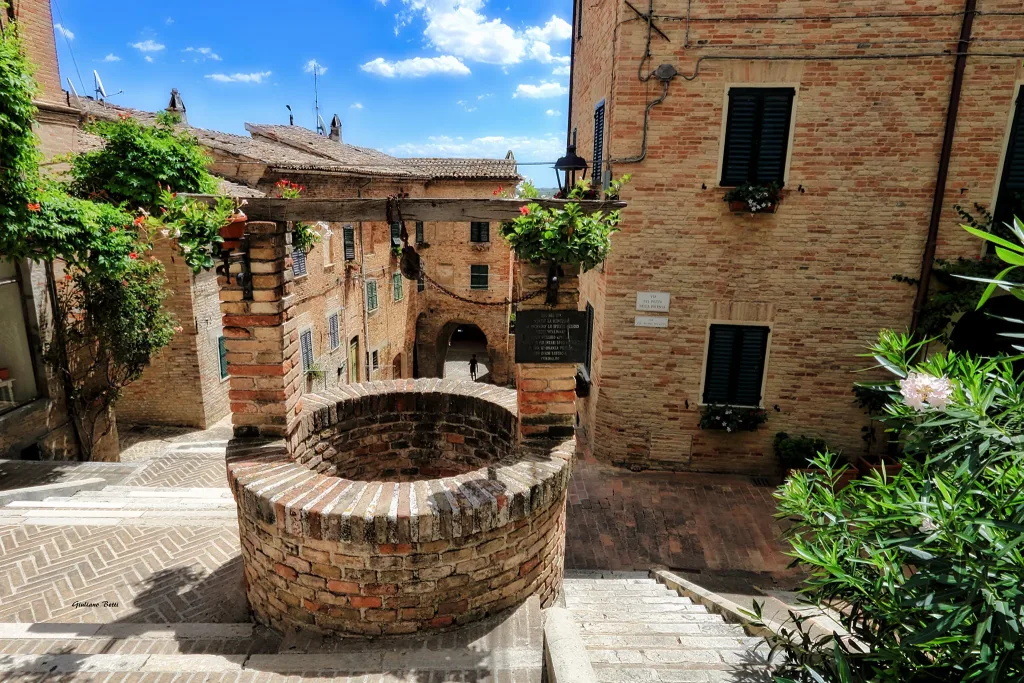
What is Polenta?
Polenta is a classic Italian dish made from granular cornmeal slowly cooked in water or broth until it becomes thick and smooth. In Le Marche, it’s usually stirred over low heat for nearly an hour, then served soft and creamy or left to cool and firm up before being sliced and grilled or fried. Once a staple of rural life, polenta remains a comforting dish often paired with sausages.
Walk Along the City Walls and Ancient Gates
Corinaldo’s fortified walls, nearly one kilometer long, are among the best-preserved in Italy. Built between the 14th and 15th centuries, they include towers, bastions, and four gates: Porta Nova, Porta di San Giovanni, Porta di Santa Maria del Mercato, and Porta di San Pietro. A walk along the walls offers spectacular views over the Marche countryside and a clear glimpse of Corinaldo’s strategic past.


Lavanda Fields – Lavandeto
Just outside the historic centre lies Il Lavandeto di Corinaldo, a picturesque lavender field that blooms alongside bright rows of sunflowers, with the town’s medieval skyline rising gently in the background. This peaceful spot is ideal for an evening stroll or a few quiet moments surrounded by the scent of lavender and the colors of the countryside.
The best time to visit is between June and July, when the fields are in full bloom and the landscape turns into a mosaic of purple and gold. Visitors are kindly asked to respect the fields, which are lovingly maintained by local farmers throughout the year.
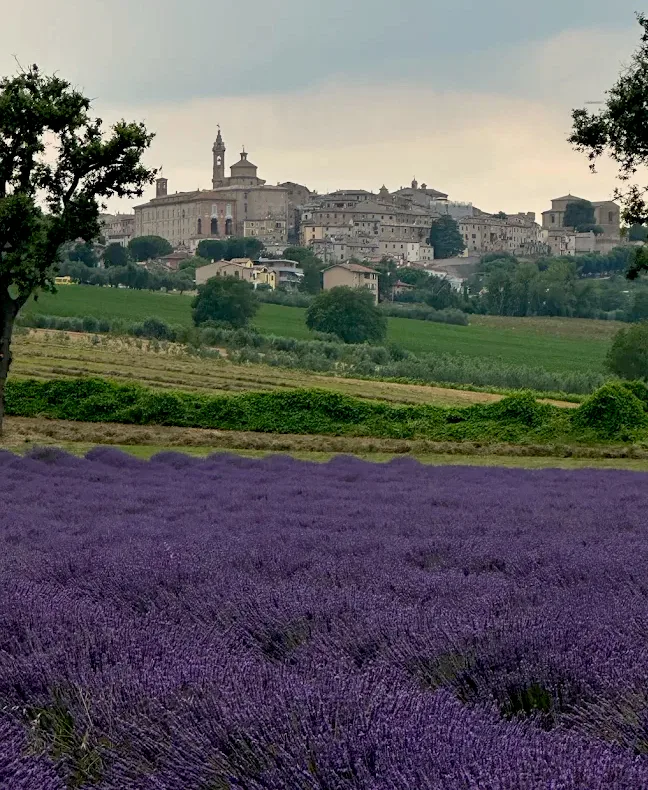
Visit the Churches
The Church of Santa Maria del Suffragio was built in 1640 on the site of a former defensive tower, following a design by Francesco Maria Ciaraffoni. Its simple brick façade is divided by sturdy pilasters, columns, and capitals, and is topped by a bell tower with a triangular pediment. A small staircase leads to the interior, which consists of a single elliptical nave covered by a coffered dome. Inside, visitors can admire an elegant floor decorated with geometric patterns and a painting of the Madonna and Child with the Saints, dated 1640 and attributed to the painter Claudio Ridolfi.
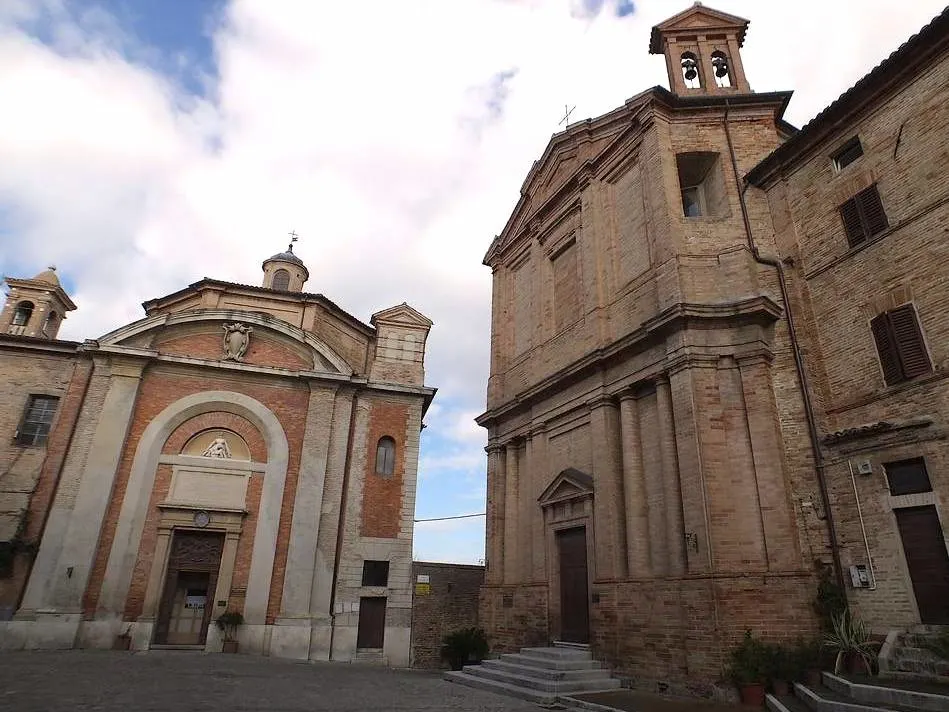
The Church of Madonna dell’Addolorata, built in the Baroque style, stands beside the ancient town walls on the site of a former 17th-century church, next to the Benedictine convent. Its exterior is elegant and well-balanced, while the interior — a single nave crowned by a lantern dome — is adorned with refined white stuccoes and Rococo-style decorations.
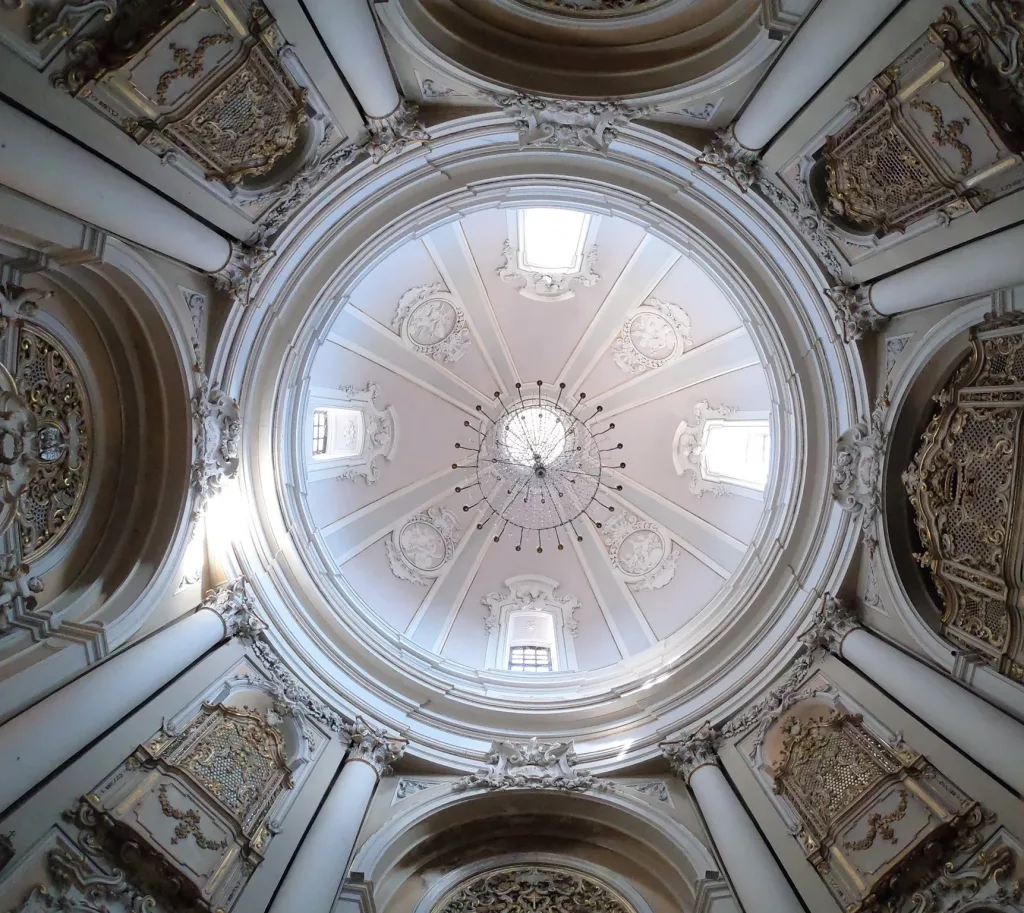
Corinaldo is the birthplace of Saint Maria Goretti, one of the most beloved modern saints in Italy. Her sanctuary, located near her family home, attracts pilgrims from around the world. The adjoining museum preserves personal objects and documents related to her life and canonization.
Explore Casa di Scuretto, Landroni and Palazzo Comunale
One of Corinaldo’s most peculiar attractions is the Casa di Scuretto, a house famous for being nothing more than a façade. According to local legend, Scuretto’s son had emigrated to the United States to seek his fortune. Working as a waiter, he regularly sent part of his earnings back home, asking his father to use the money to build a new family house for his return.
However, Scuretto was known for his love of wine and spent much of the money in Corinaldo’s taverns. When his son eventually asked for a photo of the finished house, Scuretto came up with a clever plan: he built only the front wall, complete with a door number, and had himself photographed waving from a window. He then sent the photo to his son as proof of the “completed” home.
Today, Casa di Scuretto stands as a playful symbol of Corinaldo’s humor and ingenuity, reflecting the town’s lively popular traditions.
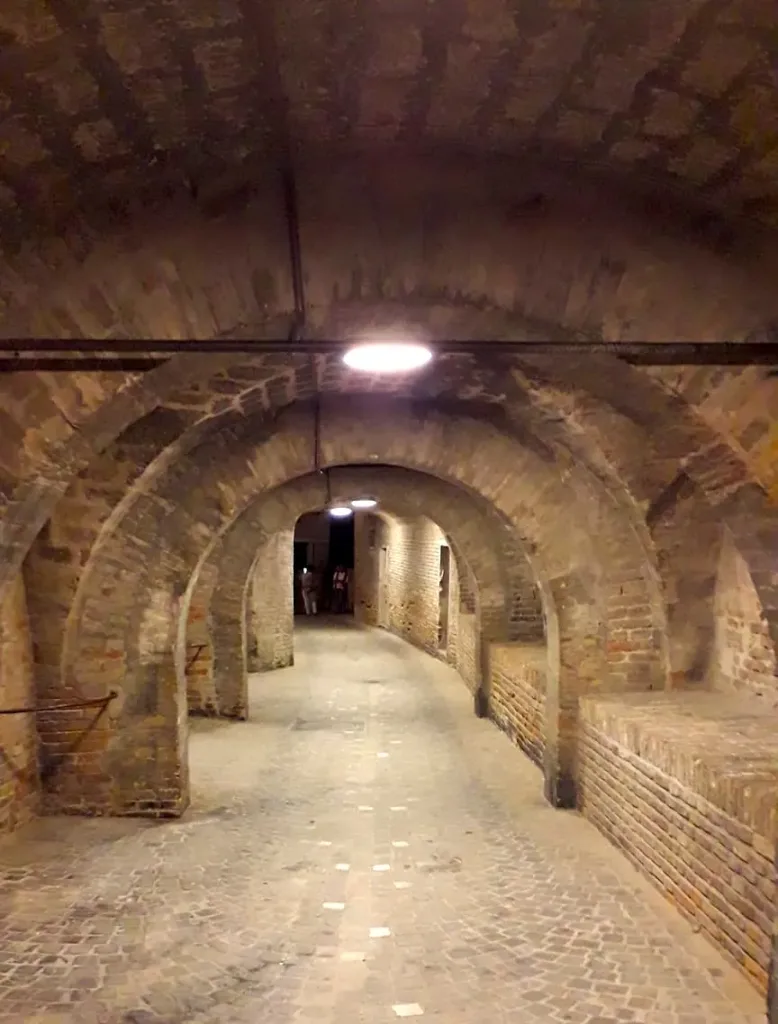
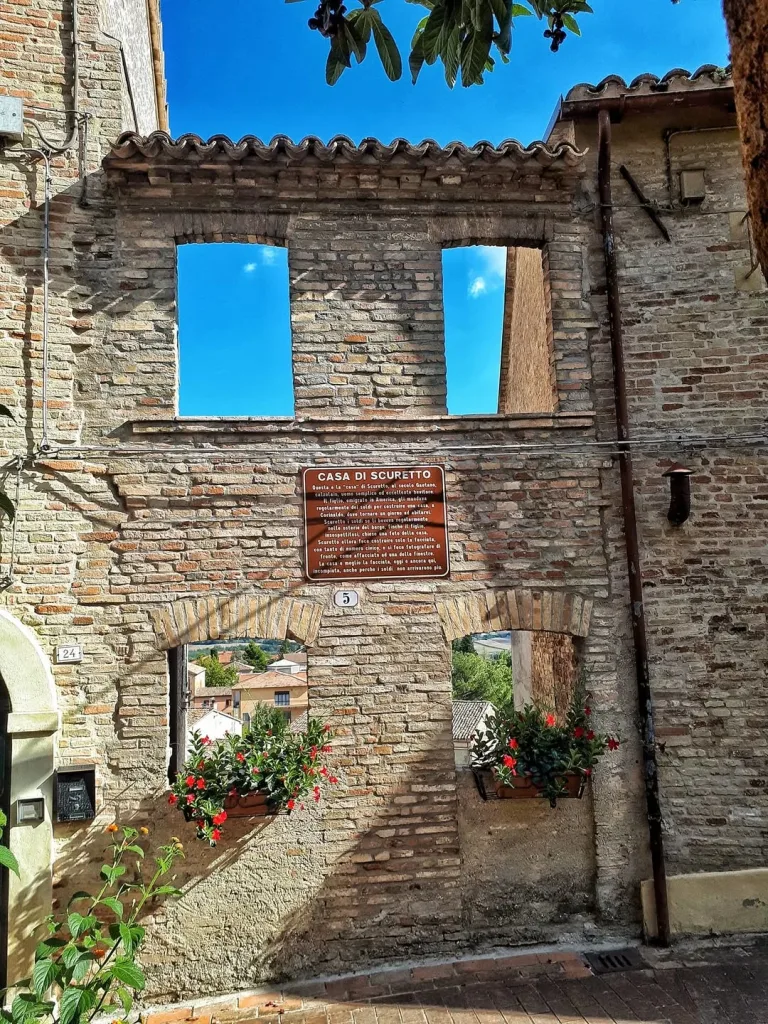
Continue along Via del Corso, a charming street lined with narrow alleys, covered passages known as Landroni, the walk leads to the Carlo Goldoni Theatre, an elegant 19th-century building located next to one of the ancient gates that once gave access to the old town.
While at the center of the historic core of the town there is Piazza del Terreno, dominated by the Palazzo Comunale (Town Hall) and its civic tower. This elegant square serves as the town’s main gathering place and a great base for exploring the narrow lanes, artisan shops, and small cafés scattered throughout the old town.

Learn About Local History at the Civic Museum
The Civic Art Collection Claudio Ridolfi in Corinaldo is a small yet valuable museum that showcases the town’s artistic and cultural heritage. Housed within the former convent of the Padri eremitani dell’ordine di Sant’Agostino (Hermit Fathers of the Order of Saint Augustine), the collection features works from the 15th to the 19th century, including paintings, sculptures, and sacred art. Opened to the public in 1996 and redesigned in 2012, it is named after the Venetian painter Claudio Ridolfi, who lived and worked in Corinaldo for many years.
Experience Corinaldo’s Festivals
- The Contesa del Pozzo della Polenta (July): commemorates the 1517 siege of Corinaldo. The siege was led by Francesco Maria I Della Rovere, the ousted Duke of Urbino, who was attempting to retake the territory.
Corinaldo, despite being besieged for over 20 days, the townspeople bravely resisted the attack, thanks in part to their strong walls and water reserves. The Duke of Urbino was ultimately forced to withdraw, unable to capture the town.
As a reward for its loyalty, Pope Leo X granted Corinaldo the status of a city after its successful defence.
While the festival is a historical reenactment of this siege, it also incorporates the folk legend of the Polenta Well, where a sack of corn flour was dropped into the well during the siege. - Festa dei Folli (Festival of Fools): a colorful and fun event that celebrates Corinaldo’s nickname, the town of crazies. Visitors can earn a Passaporto da Matto (Passport as crazy person) by completing a lighthearted challenge.
- Halloween la Festa delle Streghe (October): one of the Marche’s most famous Halloween events, transforming the town into a spectacular themed festival of lights, music, costumes, and food stands. The festival also includes the election of Miss Witch.
- Corinaldo Jazz Festival (August): A jazz music festival that brings renowned national and international artists to the town’s historic centre.
Explore the Surrounding Hills
From Corinaldo, scenic drives lead through rolling hills covered with vineyards and olive groves. Nearby attractions include Senigallia and its beaches, the wine-producing village of Morro d’Alba, and historic towns like Arcevia, Pergola and Mondavio.
Accommodations near Corinaldo
Here are some options for accommodations near Corinaldo:
Guided Activities near Corinaldo
A list of guided and bookable activities can be found below:


Comments are closed.